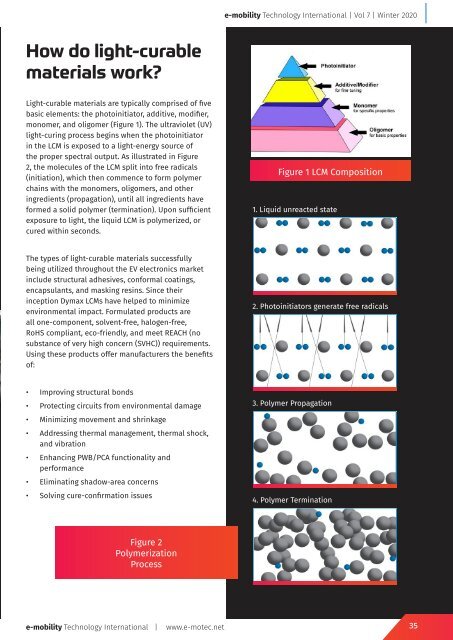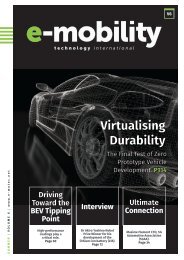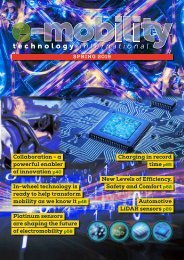E-mobility Technology Winter 2020
Electric vehicle technology news: Maintaining the flow of information for the e-mobility technology sector
Electric vehicle technology news: Maintaining the flow of information for the e-mobility technology sector
You also want an ePaper? Increase the reach of your titles
YUMPU automatically turns print PDFs into web optimized ePapers that Google loves.
e-<strong>mobility</strong> <strong>Technology</strong> International | Vol 7 | <strong>Winter</strong> <strong>2020</strong><br />
How do light-curable<br />
materials work?<br />
Light-curable materials are typically comprised of five<br />
basic elements: the photoinitiator, additive, modifier,<br />
monomer, and oligomer (Figure 1). The ultraviolet (UV)<br />
light-curing process begins when the photoinitiator<br />
in the LCM is exposed to a light-energy source of<br />
the proper spectral output. As illustrated in Figure<br />
2, the molecules of the LCM split into free radicals<br />
(initiation), which then commence to form polymer<br />
chains with the monomers, oligomers, and other<br />
ingredients (propagation), until all ingredients have<br />
formed a solid polymer (termination). Upon sufficient<br />
exposure to light, the liquid LCM is polymerized, or<br />
cured within seconds.<br />
Figure 1 LCM Composition<br />
1. Liquid unreacted state<br />
The types of light-curable materials successfully<br />
being utilized throughout the EV electronics market<br />
include structural adhesives, conformal coatings,<br />
encapsulants, and masking resins. Since their<br />
inception Dymax LCMs have helped to minimize<br />
environmental impact. Formulated products are<br />
all one-component, solvent-free, halogen-free,<br />
RoHS compliant, eco-friendly, and meet REACH (no<br />
substance of very high concern (SVHC)) requirements.<br />
Using these products offer manufacturers the benefits<br />
of:<br />
2. Photoinitiators generate free radicals<br />
• Improving structural bonds<br />
• Protecting circuits from environmental damage<br />
• Minimizing movement and shrinkage<br />
• Addressing thermal management, thermal shock,<br />
and vibration<br />
• Enhancing PWB/PCA functionality and<br />
performance<br />
• Eliminating shadow-area concerns<br />
• Solving cure-confirmation issues<br />
3. Polymer Propagation<br />
4. Polymer Termination<br />
Figure 2<br />
Polymerization<br />
Process<br />
e-<strong>mobility</strong> <strong>Technology</strong> International |<br />
www.e-motec.net<br />
35









